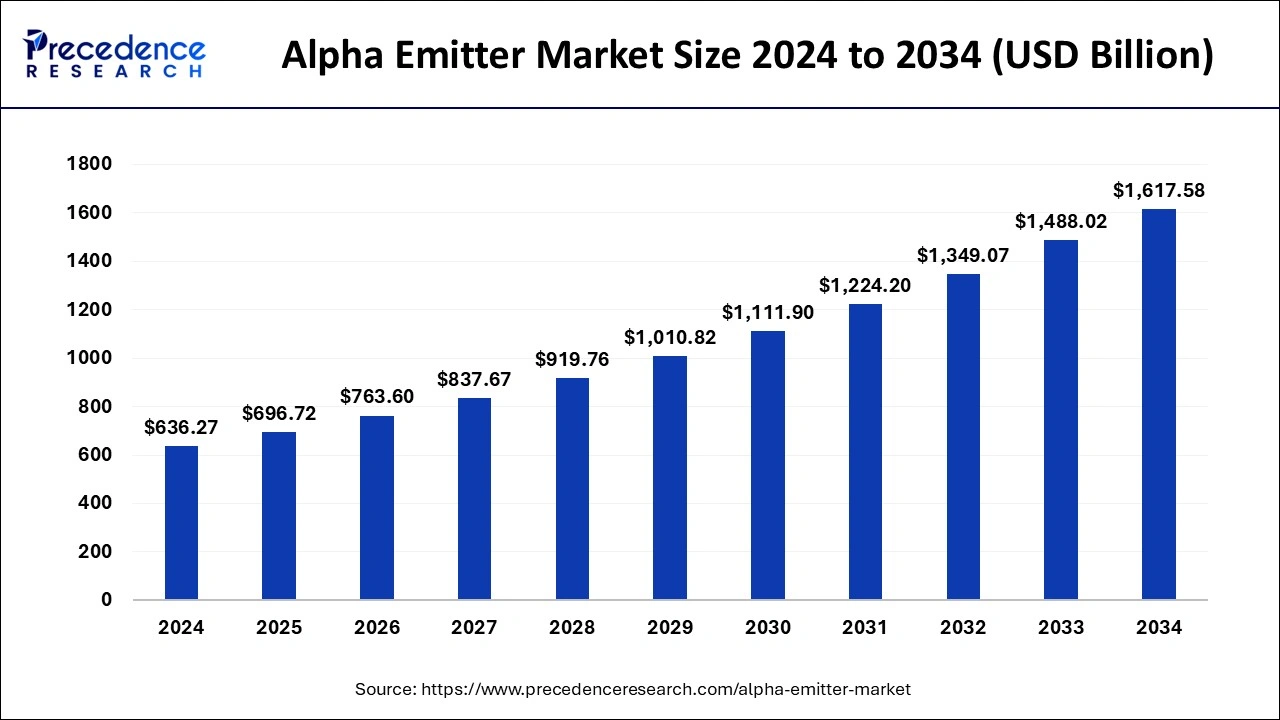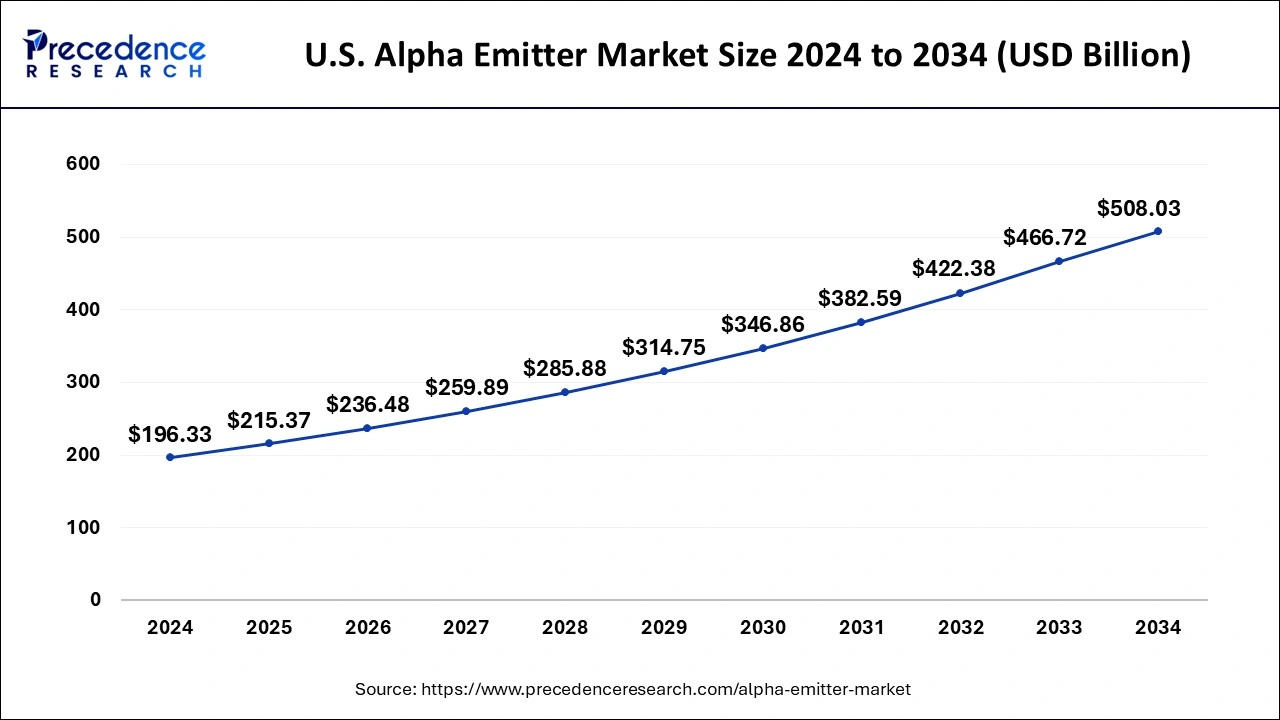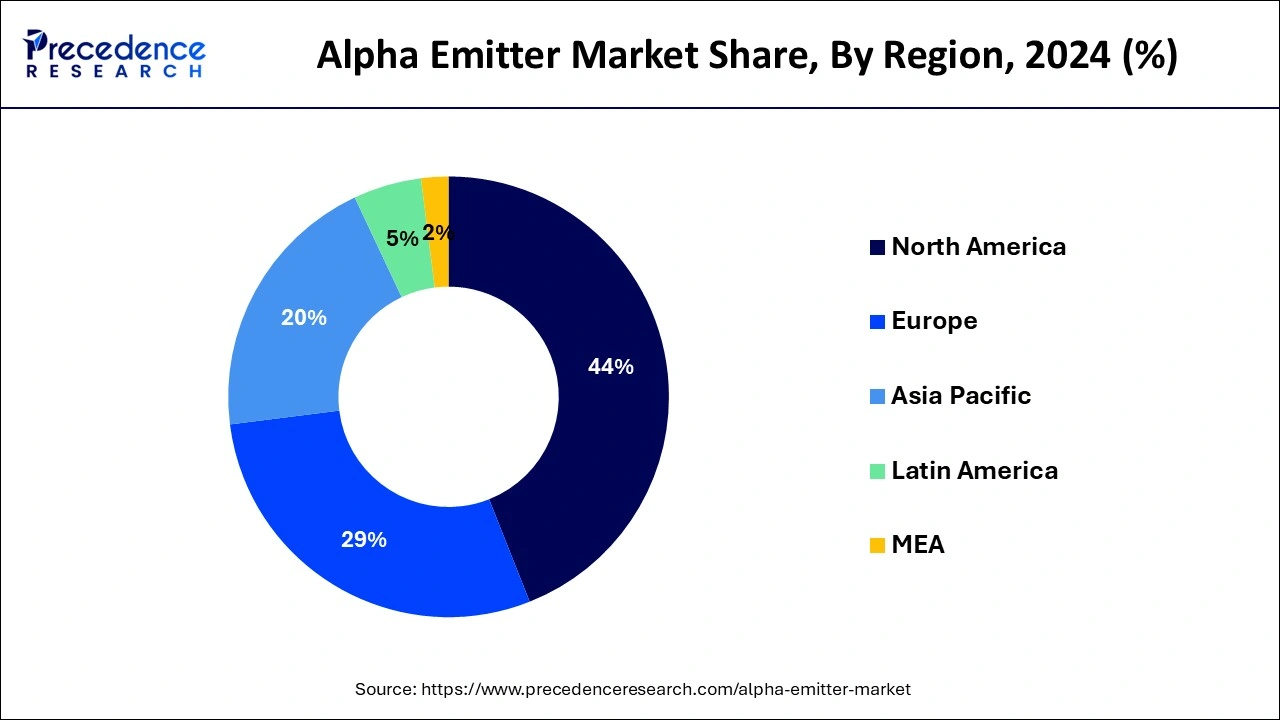The global alpha emitter market size is accounted at USD 696.72 billion in 2025 and is forecasted to hit around USD 1,617.58 billion by 2034, representing a CAGR of 9.78% from 2025 to 2034. The North America market size was estimated at USD 279.96 billion in 2024 and is expanding at a CAGR of 9.80% during the forecast period. The market sizing and forecasts are revenue-based (USD Million/Billion), with 2024 as the base year.
The global alpha emitter market size accounted for USD 636.27 billion in 2024 and is predicted to increase from USD 696.72 billion in 2025 to approximately USD 1,617.58 billion by 2034, expanding at a CAGR of 9.78% from 2025 to 2034.

The U.S. alpha emitter market size was exhibited at USD 196.33 billion in 2024 and is projected to be worth around USD 508.03 billion by 2034, growing at a CAGR of 9.97% from 2025 to 2034.

In 2024, North America held a share of 44% in the alpha emitter market due to advanced healthcare infrastructure, extensive research and development activities, and a high prevalence of cancer cases. Robust regulatory frameworks and increased investments in cutting-edge medical technologies contribute to the region's dominance. Moreover, the presence of key market players and a well-established healthcare system enhance the adoption of alpha emitter therapies. The region's focus on technological advancements and a strong commitment to cancer research solidify North America's prominent position in the alpha emitter market.

Asia-Pacific is positioned for rapid growth in the alpha emitter market due to increasing healthcare investments, rising cancer incidences, and growing awareness of advanced treatments. The region's expanding population and improving healthcare infrastructure create a conducive environment for the adoption of innovative therapies. Additionally, collaborative efforts between governments, research institutions, and industry players contribute to the development and accessibility of alpha emitter technologies. These factors collectively drive the market's expansion, making the Asia-Pacific region a key player in advancing alpha emitter applications for effective cancer treatment.
Meanwhile, Europe is witnessing notable growth in the alpha emitter market due to a combination of factors. Increased healthcare expenditure, a proactive approach to research and development, and a growing aging population contribute to the demand for advanced cancer therapies. The region's emphasis on technological innovations, coupled with supportive regulatory frameworks, fosters the development and adoption of alpha emitter technologies. Moreover, collaborations between industry and research entities enhance the market's momentum. These factors collectively position Europe as a significant hub for the expansion and advancement of alpha emitter applications in cancer treatment.
An alpha emitter is a type of radioactive substance that releases alpha particles. Alpha particles consist of two protons and two neutrons, making them relatively large and positively charged. Due to their size and charge, alpha particles have low penetration abilities, and they are usually stopped by a sheet of paper or human skin. Common examples of alpha emitters include certain isotopes of uranium and thorium. The process of alpha decay occurs when an unstable atomic nucleus emits an alpha particle to achieve a more stable state. While alpha emitters can pose health risks if not handled properly, their properties make them useful in various scientific and medical applications, such as in smoke detectors and cancer treatments.
| Report Coverage | Details |
| Growth Rate from 2025 to 2034 | CAGR of 9.78% |
| Market Size in 2025 | USD 696.72 Billion |
| Market Size by 2034 | USD 1,617.58 Billion |
| Base Year | 2024 |
| Forecast Period | 2025 To 2034 |
| Segments Covered | Type of Radionuclide, Application, Source |
| Regions Covered | North America, Europe, Asia-Pacific, Latin America, and Middle East & Africa |
Increasing incidence of cancer
The increasing incidence of cancer is a major driving factor behind the growing demand for alpha emitters in the market. As more people are diagnosed with cancer globally, there is a pressing need for effective and innovative treatments.
This rise in cancer cases has created a significant market demand for advanced therapies, and alpha emitters, with their unique properties in targeting cancer cells, have become crucial players in this scenario. Patients and healthcare providers are seeking treatments that offer better outcomes, and alpha emitters show promise in addressing this need. The demand for these technologies is fueled by the urgency to find solutions for the increasing burden of cancer, making the alpha emitter market a key player in the ongoing efforts to improve cancer treatment options globally.
Concerns regarding contrast agent safety
Concerns about radiation exposure act as a significant restraint on the market demand for alpha emitters. Despite the targeted nature of alpha radiation, there exists apprehension among both healthcare providers and patients regarding potential side effects and safety. People may be hesitant to embrace alpha emitter treatments due to the lingering fears associated with radiation, even though these therapies are designed to minimize damage to healthy tissues. Building confidence in the safety of alpha emitters and addressing misconceptions is crucial for market growth.
Education and awareness campaigns can play a pivotal role in helping healthcare professionals and patients understand the controlled and focused nature of alpha radiation, highlighting its benefits in targeted cancer treatment. Overcoming these concerns is essential for the alpha emitter market to gain broader acceptance and meet the rising demand for effective and safer cancer therapies.
Expanding applications beyond oncology
Expanding applications beyond oncology presents significant opportunities for the alpha emitter market. While alpha emitters are currently recognized for their role in cancer treatment, their unique properties make them promising in other medical fields. For instance, in imaging and diagnostics, alpha emitters can offer more precise and detailed information for healthcare professionals, leading to improved diagnostics and patient care.
Furthermore, exploring applications in non-oncological conditions, such as certain autoimmune diseases or targeted therapies, can broaden the market's appeal. This diversification not only positions alpha emitters as versatile tools in the medical field but also attracts attention from a wider range of healthcare sectors. As research expands into these new applications, the alpha emitter market has the potential to become a key player in addressing various medical challenges beyond cancer, enhancing its overall market presence and impact.
The actinium (Ac-225) segment held the highest market share of 38% in 2024. The actinium (Ac-225) segment in the alpha emitter market refers to the utilization of the radionuclide Actinium-225 for medical applications, particularly in cancer treatment. Ac-225 emits alpha particles, making it suitable for targeted alpha-particle radiotherapy. Recent trends indicate a growing interest in Actinium-225 due to its effectiveness in delivering localized radiation to cancer cells while minimizing damage to surrounding healthy tissues. This segment's prominence reflects the increasing recognition of Actinium-225 as a promising tool in the evolving landscape of precision oncology and targeted therapies.
The radium (Ra-223) segment is anticipated to witness rapid growth at a significant CAGR of 10.16% during the projected period. In the alpha emitter market, the radium (Ra-223) segment refers to the use of radium-223, a radioactive isotope, primarily recognized for its application in targeted alpha-particle therapy for prostate cancer metastases in bones. This segment is witnessing a growing trend as Ra-223 demonstrates efficacy in addressing skeletal metastases, offering a targeted approach to alleviate symptoms and improve patient outcomes. The increasing focus on precision medicine and advancements in radionuclide therapies contribute to the upward trajectory of the radium (Ra-223) segment in the alpha emitter market.
The bone metastases segment held a 36% market share in 2024. In the alpha emitter market, the bone metastases segment refers to the application of alpha emitters in treating cancer that has spread to the bones. This segment addresses the specific challenge of metastatic bone lesions, providing targeted radiation to reduce tumor growth. A growing trend in this application involves ongoing research to optimize the efficacy of alpha emitters for bone metastases, offering patients a potentially more effective and less invasive treatment option compared to traditional therapies. The focus on refining these treatments signifies a positive trend in addressing the complexities of bone metastases using alpha emitters.
The prostate cancer segment is anticipated to witness rapid growth over the projected period. In the alpha emitter market, the prostate cancer segment focuses on utilizing alpha-emitting isotopes for targeted therapy in prostate cancer patients. This application involves delivering radiation precisely to prostate cancer cells, minimizing damage to surrounding healthy tissues. Current trends in this segment include ongoing research to optimize treatment protocols, improve patient outcomes, and enhance the overall efficacy of alpha emitter therapies specifically tailored for prostate cancer. The aim is to provide a more targeted and efficient treatment option for individuals diagnosed with prostate cancer, aligning with the broader trend towards personalized and precision medicine in oncology.
The natural sources segment held a 54% market share in 2024. In the alpha emitter market, the natural sources segment refers to alpha-emitting radionuclides that occur naturally, such as certain isotopes of uranium and thorium. These sources have gained attention for their use in medical applications, including cancer treatments. A trend in this segment involves harnessing the therapeutic potential of naturally occurring alpha emitters, aligning with a growing interest in exploring and optimizing the use of these elements for targeted and effective medical interventions, thereby contributing to advancements in the field of oncology.
The artificially produced sources segment is anticipated to witness rapid growth over the projected period. Artificially produced sources in the alpha emitter market refer to those generated through human-controlled processes, distinct from natural sources. These sources often involve the synthesis of specific isotopes with desirable properties for medical applications. A notable trend in this segment is the continuous refinement of production methods, enabling the creation of alpha emitters with enhanced targeting capabilities and reduced side effects. Advancements in artificial production techniques contribute to the development of more effective and precise alpha emitter therapies, driving innovation in the market.
By Type of Radionuclide
By Application
By Source
By Geography
For inquiries regarding discounts, bulk purchases, or customization requests, please contact us at sales@precedenceresearch.com
No cookie-cutter, only authentic analysis – take the 1st step to become a Precedence Research client